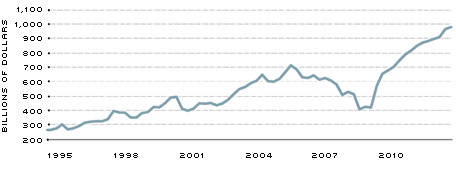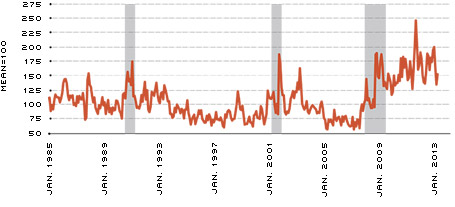Uncertainty and the Economy
For a while now, comments from financial market participants and business executives have suggested that high levels of uncertainty have been a key reason for the economy's sluggish performance during the current business expansion. If the business and financial community believes the near-term outlook is murkier than usual, then the pace of hiring and outlays for capital spending projects may be unnecessarily constrained, thereby slowing the overall pace of economic activity.
Monetary policymakers are also not immune to the challenges posed by rising levels of economic uncertainty. This has been noted in the minutes of several recent meetings of the Federal Open Market Committee (FOMC). Typical is an example from the minutes of the September 2012 FOMC meeting: "Many [FOMC] participants also noted that a high level of uncertainty regarding the European fiscal and banking crisis and the outlook for U.S. fiscal and regulatory policies was weighing on confidence, thereby restraining household and business spending."
This article will discuss the concept of economic uncertainty, how some economists measure it and how rising uncertainty can slow the growth of economic activity.
Defining Uncertainty: Some Basic Economics
Uncertainty and its effects on commerce (business decision-making) are often studied in the context of decisions to expand—chiefly through increased hiring and additions to the capital stock (fixed investment). These decisions naturally affect the firm's profits. The link between uncertainty and profit was further refined by introducing the concept of risk. To many lay people, risk and uncertainty appear to be the same thing, but to economists there is a subtle distinction. The difference between risk and uncertainty was discussed nearly 100 years ago by the economist Frank Knight.
According to Knight: "There is a fundamental distinction between the reward for taking a known risk and that for assuming a risk whose value itself is not known. It is so fundamental, indeed, that … a known risk will not lead to any reward or special payment at all."1
What Knight meant is that the unfavorable outcome of a known risk can be insured against during the decision-making process because it has a well-defined distribution of expected probabilities. Life insurance companies, for example, have a reasonably accurate estimate of how many policies will pay off in a given year because of mortality statistics. However, an unknown risk does not have a known distribution of expected probabilities. For example, should a firm devote its scarce resources to plan against a computer virus that shuts down a key part of the nation's electrical grid even if it has no idea what the probability is for such an event? Knight's characterization of unknown risk has subsequently been termed "Knightian uncertainty" by economists.
How Uncertainty Affects the Economy
One of the first attempts to rigorously model the effects of uncertainty on business investment was published by Ben Bernanke in 1983. The current Federal Reserve chairman was then a Stanford University professor. In his analysis, Bernanke noted that macro-level factors—such as unexpected changes in oil prices, changes in monetary and fiscal policies, or the advent of new technologies with widespread applications—are important at the micro level, that is, a firm's decision to invest. This decision takes on increased importance for long-lived investment projects that are economically costly to reverse.2 Thus, as new information arrives, the business (or bank or investor) may find that the odds of making a better, more-informed decision increase by waiting for additional information. In other words, the firm finds that there is an option value for waiting to invest.
This option value will become more or less valuable to the firm depending on the level of uncertainty it perceives in the economy. Increased uncertainty arising from macro-level factors, then, can become an important factor for business investment and, thus, for the economy. According to Bernanke: "When the option value is large, investors are willing to sacrifice current returns in order to receive more information. The bad news principle is hard at work here: High uncertainty and the possibility that new information will change project rankings depress current investment."3
Measuring Economic Uncertainty
Discussions about the pervasiveness of uncertainty—whatever its source and persistence—and, thus, its effects on the economy quickly lead to a follow-up question: How do economists—or business executives and bankers—measure uncertainty? One measure might be the amount of cash that firms hold on their balance sheets. Firms hold cash and cash equivalents for many reasons. One is to finance investment. However, investment is also financed via equity issuance or via loans from financial institutions. Reflecting the aforementioned option value of waiting, a firm may accumulate cash instead of financing investment if it deems the macroeconomic environment too uncertain to determine the investment's rate of return.
Figure 1 shows that cash and cash-equivalent assets on the balance sheet of nonfinancial corporate businesses totaled a bit less than $1 trillion as of Dec. 31, 2012. While an all-time high in nominal terms, this amounted to only a little more than 6 percent of total financial assets. Still, its share at the end of 2012 was the largest in a little more than 13 years.
Cash and Other Liquid Assets on Corporate Balance Sheets

NOTE: Cash is checking deposits and currency; other liquid assets are time and savings deposits. Holdings of nonfarm, nonfinancial corporations. Data through 2012:Q4.
SOURCE: Flow of Funds (Federal Reserve).
Economic Policy Uncertainty Index

SOURCE: www.PolicyUncertainty.com and Haver Analytics.
Last actual observation is March 2013.
Researchers at the Federal Reserve Bank of St. Louis recently examined the reasons for the increased accumulation of cash on corporate balance sheets.4 They argued that increased levels of economic uncertainty are one reason for the recent upsurge in hoarding of cash by firms. However, there are other valid reasons. These include increased competition, especially in the information technology sector, and financing of research and development. Another reason stems from a relatively high U.S. corporate tax rate on income generated from foreign operations and subsidiaries.
In measuring uncertainty, economists realize that there are several potential sources that restrain firms' hiring and investment plans. A further complication is that different types of uncertainty will affect some sectors of the economy more than others. This is particularly true in the realm of economic policy. For example, the pending expiration of an investment tax credit may create more uncertainty for a large capital-intensive manufacturer than for a financial firm or retailer.
A second measure of economic uncertainty is an index designed to measure economic policy uncertainty. Figure 2 plots the Economic Policy Uncertainty Index, which is the product of work by Stanford University economists Scott Baker and Nicholas Bloom and by University of Chicago economist Steven Davis.5 The Baker-Bloom-Davis (BBD) measure of economic uncertainty is comprised of three underlying components: (i) newspaper articles derived from a Google news search that contain words like "uncertainty," "economy," "policy," "Federal Reserve" and "deficit"; (ii) the number of provisions in the U.S. tax code set to expire in future years; and (iii) disagreement among economic forecasters. Index values above 100 indicate above-average levels of uncertainty, while the opposite holds for values below 100.
Increases in the economic uncertainty index tend to be associated with declines (or slower growth) in real GDP and in real business fixed investment.6 This can be inferred from Figure 2 because the BBD measure of economic uncertainty rises sharply immediately before and during recessions, and then drifts back to lower levels after the recession ends. Importantly, the index shows that economic policy uncertainty has been at exceptionally high levels during much of this business expansion—levels that normally occur during recessions (shaded bar areas in Figure 2).
The BBD index seems to accurately portray the anecdotal evidence reported in the financial media and encountered by FOMC officials. As can be seen in the figure, uncertainty has been unusually high for the past few years. It is worth noting, though, that the BBD index is potentially biased. Suppose that an increasing number of economists, policymakers and financial market participants refer to the BBD index and use it as a tool to measure uncertainty or forecast the effects of uncertainty on the economy. To the extent that this analysis is reported and picked up in the index's Google citation component, the index will run higher. But since the BBD index is comprised of other components, this bias may be relatively small and inconsequential.
Endnotes
- See Knight, p. 21. [back to text]
- Dixit and Pindyk provided subsequent analysis of investment under uncertainty. [back to text]
- See Bernanke. [back to text]
- See Sanchez and Yurdagul. [back to text]
- See Baker, Bloom and Davis. [back to text]
- Business fixed investment in equipment and software, as well as in structures, is the component of real final sales (GDP less inventory investment) that is most sensitive to the business cycle. Thus, investment typically falls sharply during recessions, but then recovers sharply during expansions, on average. [back to text]
References
Baker, Scott R.; Bloom, Nicholas; and Davis, Steven J. "Measuring Economic Policy Uncertainty." Chicago Booth Research Paper No. 13-02, January 2013. See www.policyuncertainty.com/media/BakerBloomDavis.pdf
Bernanke, Ben S. "Irreversibility, Uncertainty, and Cyclical Investment." The Quarterly Journal of Economics, February 1983, Vol. 98, No. 1, pp. 85-106.
Dixit, Avinash K.; and Pindyck, Robert S. Investment under Uncertainty. Princeton, N.J.: Princeton University Press, 1994.
Knight, Frank H. Risk, Uncertainty, and Profit. John McClure, ed. Kissimmee, Fla.: Signalman Publishing, 2009.
Sánchez, Juan M.; and Yurdagul, Emircan. "Why Are Corporations Holding So Much Cash?" Federal Reserve Bank of St. Louis' The Regional Economist, January 2013, Vol. 21, No. 1, pp. 5-8.
Views expressed in Regional Economist are not necessarily those of the St. Louis Fed or Federal Reserve System.
For the latest insights from our economists and other St. Louis Fed experts, visit On the Economy and subscribe.
Email Us


